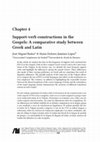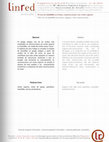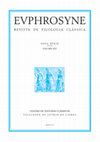Papers by M. Dolores Jiménez López

Glotta, 2024
Verb-noun collocations (VNCs), constructions lying between lexicon and syntax, pose a challenge t... more Verb-noun collocations (VNCs), constructions lying between lexicon and syntax, pose a challenge to translators and are the reason for errors and interferences in second language users or in language communities in contact, due to their idiosyncratic nature. In the New Testament, composed in Koine Greek, some VNCs can be identified as ‘anomalous’ from the point of view of literary classical Greek and be explained as the result of the interaction between the different languages that coexisted in the context of its creation. In this article we will examine VNCs in which ποιέω and ἐργάζομαι alternate in combinations with nouns from the semantic field of ἀνομία, ἁμαρτία and δικαιοσύνη. As will be seen, these collocations were first configured in the Septuagint as literal word-for-word translations of Hebrew collocations with two different verbs. This explains their later use in the New Testament and their development in Latin through their translation in the Vulgate.
Emerita, 2024
Ancient Greek employs, like other languages, inchoative collocations with verbs meaning ‘to fall’... more Ancient Greek employs, like other languages, inchoative collocations with verbs meaning ‘to fall’ in combination with nouns of feeling, experience or negative situations (caer en una enfermedad, to fall in love, cadere in disgrazia). This paper analyses this type of collocations with (ἐμ)πίπτω
from Homer to the 3rd century AD: it studies when and how the metaphors underlying such collocations have been activated, what syntactic schemes
they present (fall N / fall into N), what kinds of nouns are involved in these lexical combinations, and what is their evolution over time from their
beginnings in Homeric epic to their productive use in post-classical Greek.

Victoria Beatrix Fendel (ed.), Support-verb constructions in the corpora of Greek: Between lexicon and grammar? Berlin: Language Science Press, 2024
In this article we analyse the data on the frequency of support-verb constructions (SVCs) in the ... more In this article we analyse the data on the frequency of support-verb constructions (SVCs) in the Gospels, both in their original Greek version and in the Latin translation of the Vulgate. In the former case, we identify the most frequent support verbs and highlight the differences among the gospel writers. These differences also speak of their varying proficiency in Greek and are sometimes the result of linguistic influences. The parallel analysis of the Latin text of the Vulgate allows us to compare the use of SVCs in both languages and reflect on the translation criteria employed. The evidence, in addition to highlighting the reasonable tension between the literal translation of the source language (Greek) and the naturalness of the target language (Latin), demonstrates the existence of different translation criteria in each Gospel.
M. López Salvá (ed.), Los primeros cristianismos y su difusión, Tarragona, Rhemata Monografías., 2023
A fundamental factor in explaining the genesis and development of new verb-noun collocations in b... more A fundamental factor in explaining the genesis and development of new verb-noun collocations in biblical Greek and Latin is the very process of literal translation of these sacred texts, either from Hebrew and Aramaic into Greek in the case of the Septuagint, or from Hebrew and Greek into Latin in the case of the Vulgate. A good example of this is the use of operor in the Vulgate with nouns such as iniquitas, abominatio, peccatum, impietas, scelus and iniustitia, a semantic field in which operor alternates with the support verb facio and in which it forms, at first as translation calques, collocations which were not attested until then in Latin literature but were soon to spread to the whole of Christian literature and have continuity in the Romance languages.

En griego antiguo uno de los verbos más empleados en construcciones con verbo soporte es ποιεῖσθα... more En griego antiguo uno de los verbos más empleados en construcciones con verbo soporte es ποιεῖσθαι, voz media del verbo ποιέω ‘hacer’. El objetivo de este trabajo es estudiar el empleo de ποιεῖσθαι en griego antiguo a partir del análisis de la obra de Lisias. Se pone de manifiesto que este verbo presenta un número limitado de estructuras sintácticas y que su empleo más frecuente es, precisamente, en construcciones con verbo soporte. Se estudia el alcance de este empleo y las características semánticas y sintácticas de estas construcciones en Lisias.In Ancient Greek, ποιεῖσθαι (middle voice of the verb ποιέω ‘to make, to do’) is, par excellence, one of the most common verbs constituting support verb constructions. The aim of this paper is to study the use of ποιεῖσθαι in Ancient Greek from the analysis of the works of Lysias. We will show that the use of this verb is limited to very few syntactic structures and that the most common ones are the so‐called support verb constructi...
Díaz Calvente, Tamara: "Pompeya y la adquisición de competencias básicas por parte de los escolar... more Díaz Calvente, Tamara: "Pompeya y la adquisición de competencias básicas por parte de los escolares". Dtora. Patricia Cañizares Ferriz. García Riesco, Soraya: "La enseñanza de las competencias básicas en el tema de la arquitectura e ingeniería en Roma. La adquisición de competencias básicas por parte de los escolares". Dtora. Patricia Cañizares Ferriz. Hermoso Peralo, Sara: "La adquisicion de competencias básicas en el tema "Los origenes míticos de Atenas y Tebas" en las asignaturas de griego 1º bachillerato.
Cuadernos de Filología Clásica. Estudios Latinos
Resumen. En este trabajo nos proponemos analizar las razones lingüísticas por las que los verbos ... more Resumen. En este trabajo nos proponemos analizar las razones lingüísticas por las que los verbos griegos μετανοέω y μεταμέλομαι ('arrepentirse') del Nuevo Testamento se traducen en la Vulgata, bien mediante un verbo simple (paenitere), bien, lo más frecuente, mediante distintas colocaciones: paenitentiam agere, paenitentiam habere, paenitentiā ductus y paenitentiā motus. Para profundizar en los criterios que guían la traducción latina, analizaremos, por un lado, las diferencias entre μετανοέω y μεταμέλομαι en griego clásico y neotestamentario, y, por otro, los criterios de empleo de la doble construcción sintáctica de paenitere (impersonal y personal) y de las distintas colocaciones con paenitentia en el Nuevo Testamento y a lo largo de la historia del latín.
Babel a través del espejo. Homenaje a Joaquín Rubio Tovar, 2021
El contenido de este libro no podrá ser reproducido, ni total ni parcialmente, sin el previo perm... more El contenido de este libro no podrá ser reproducido, ni total ni parcialmente, sin el previo permiso escrito del editor. Todos los derechos reservados.
G.K. Giannakis, L. Conti, J. de la Villa & R. Fornieles (eds.), Synchrony and Diachrony of Ancient Greek. Language, Linguistics and Philology. Essays in Honor of Emilio Crespo, Berlin/Boston, De Gruyter., 2021
Les constructions à verbe support en latin, eds. C. Bodelot - O. Spevak, Cahiers du LRL 7, Clermont-Ferrand., 2018
A typology of collocation errors in learning processes and the use of second languages has been ... more A typology of collocation errors in learning processes and the use of second languages has been put forward for modern languages. Given the characteristics and the plurilingual context of composition of the New Testament, some cases of already known latinisms and semitisms take on a new dimension when seen from this perspective: they have slipped into the Greek text precisely in collocations because these constructions test the linguistic competence of a second language user. In this paper we study some examples of verbo-nominal collocations in the Gospels and the Acts of the Apostles which, both in Greek and in the Latin of the Vulgate, can be better understood by applying this typology of errors.
Donum amicitiae: estudios en homenaje al profesor Vicente Picón García / coord. por Antonio Cascón Dorado, 2008, ISBN 978-84-8344-108-4, págs. 53-78, 2008

Phílos hetaîros. Homenaje al profesor Luis M. Macía, Madrid, UAM Ediciones, 2018, 189-207., 2018
Resumen– En este trabajo se analizan las distintas colocaciones verbo-nominales con uota en las R... more Resumen– En este trabajo se analizan las distintas colocaciones verbo-nominales con uota en las Res Gestae diui Augusti (uota nuncupare, soluere, suscipere) y su traducción en la versión griega (εὐχὰς ποιεῖσθαι, ἀποδιδὀναι y ἀναλαμβάνειν, respectivamente). La comparación entre las dos lenguas ofrece datos interesantes, por un lado, sobre la naturaleza misma de estas colocaciones y, por otro, sobre la competencia lingüística del autor de la traducción griega de las Res Gestae.
Vota nuncupare = ευχας ποιειςθαι: ον τηε greek version of augustus' Res Gestae Abstract– The aim of this paper is to analyse the different verbonominal collocations with uota in the Res Gestae divi Augusti (uota nuncupare, soluere, suscipere) and their translation in the Greek version (εὐχὰς ποιεῖσθαι, ἀποδιδόναι and ἀναλαμβάνειν, respectively). The comparison between the two languages offers interesting reflections both on the features of these analytical constructions, as well as on the linguistic competence of the author of the Greek translation of the Res Gestae.

ABSTRACT: In the New Testament Vulgate, the Greek verb μισέω (“to hate”) is translated either as ... more ABSTRACT: In the New Testament Vulgate, the Greek verb μισέω (“to hate”) is translated either as the Latin verb odi, or as the constructions with support verb odio habeo and odio sum.
In order to understand the criteria that explain these three translations, we will analyze, from a diachronic perspective, the use of odio habeo and odio sum in the Latin literature from Plautus to Gellius. We will also discuss, in a synchronic view, their survival in late Latin, with special attention to the different translations of μισέω in the Vulgate and in the previous versions of the Vetus Latina. The semantic and syntactic differences between odio habeo and odio sum, on the one hand, and between these two collocations and the verb odi, on the other, constitute other purpose of this paper: whereas odio sum is the lexical expression of the passive of odi, odio
habeo shares contexts with odi, but in complementary distribution.
Studies on collocations highlight the difficulties that these constructions entail for second-lan... more Studies on collocations highlight the difficulties that these constructions entail for second-language speakers. In cases of bilingualism or contact languages, for instance,
there are frequent loanwords and linguistic interferences. This study reveals that such phenomena contribute to explain the origin of verbal collocations with συμβούλιον in the New Testament, the selection of support verbs (λαμβάνω, δίδωμι, ποιέω), and differences of treatment between the authors that use them, namely Mark and Matthew. A comparison with Classical Greek as well
as with the Latin Vulgata will allow us to offer an overview of verbal collocations with the noun συμβούλιον. This will help us understand more broadly the phenomenon of collocations in the Greek New Testament.

Cuadernos de Filología Clásica. Estudios Latinos, 2017
Abstract. In this paper, our purpose is to analyze the linguistic reasons why the Greek verbs of ... more Abstract. In this paper, our purpose is to analyze the linguistic reasons why the Greek verbs of the New Testament μετανοέω and μεταμέλομαι (‘to repent’) are translated in the Vulgate, either as a simple verb
(paenitere), or, most frequently, as different collocations: paenitentiam agere, paenitentiam habere, paenitentiā ductus and paenitentiā motus. In order to understand better the criteria that guide the Latin
translation, we will analyze, on the one hand, the differences between μετανοέω and μεταμέλομαι,
and, on the other hand, the criteria for using the double syntactic construction of paenitere (impersonal and personal) and the different collocations with paenitentia in the New Testament and throughout the history of Latin.
Resumen. En este trabajo nos proponemos analizar las razones lingüísticas por las que los verbos griegos μετανοέω y μεταμέλομαι (‘arrepentirse’) del Nuevo Testamento se traducen en la Vulgata, bien
mediante un verbo simple (paenitere), bien, lo más frecuente, mediante distintas colocaciones: paenitentiam agere, paenitentiam habere, paenitentiā ductus y paenitentiā motus. Para profundizar en los
criterios que guían la traducción latina, analizaremos, por un lado, las diferencias entre μετανοέω y μεταμέλομαι en griego clásico y neotestamentario, y, por otro, los criterios de empleo de la doble construcción sintáctica de paenitere (impersonal y personal) y de las distintas colocaciones con paenitentia en el Nuevo Testamento y a lo largo de la historia del latín.
Omnia Mutantur. Canvi, transformació i pervivència en la cultura clàssica, en les seves llengües i en el seu llegat.
This paper presents relevant information for the entry of the verb παρασκευάζω in a future dicti... more This paper presents relevant information for the entry of the verb παρασκευάζω in a future dictionary of syntactic constructions. The data analysis shows its truly productive structures of complementation in ancient Greek as well as the morphological, semantic and syntactic factors involved in its construc- tion. Among other things, the diathesis is essential to understand the alternation between Purpose and Beneficiary for the third participant.
Espacios míticos: historias verdaderas, historias literarias, 2014
1 Una visión concisa y valiosa en la que puede seguirse el curso del mito a lo largo del tiempo e... more 1 Una visión concisa y valiosa en la que puede seguirse el curso del mito a lo largo del tiempo es la de Lowell Edmunds, Oedipus, Londres-Nueva York: Routledge, 2006. Véase también el reciente y completo estudio de Carlos García Gual, Enigmático Edipo. Mito y tragedia, México: Fondo de Cultura Económica, 2012. VVAA, Espacios míticos: Historias verdaderas, historias literarias, Madrid, El Jardín de la Voz, 2014.
Encyclopedia of Ancient Greek Language and Linguistics. Volume 2 G-O., 2014
This is a digital offprint for restricted use only | © 2014 Koninklijke Brill NV










Uploads
Papers by M. Dolores Jiménez López
from Homer to the 3rd century AD: it studies when and how the metaphors underlying such collocations have been activated, what syntactic schemes
they present (fall N / fall into N), what kinds of nouns are involved in these lexical combinations, and what is their evolution over time from their
beginnings in Homeric epic to their productive use in post-classical Greek.
Vota nuncupare = ευχας ποιειςθαι: ον τηε greek version of augustus' Res Gestae Abstract– The aim of this paper is to analyse the different verbonominal collocations with uota in the Res Gestae divi Augusti (uota nuncupare, soluere, suscipere) and their translation in the Greek version (εὐχὰς ποιεῖσθαι, ἀποδιδόναι and ἀναλαμβάνειν, respectively). The comparison between the two languages offers interesting reflections both on the features of these analytical constructions, as well as on the linguistic competence of the author of the Greek translation of the Res Gestae.
In order to understand the criteria that explain these three translations, we will analyze, from a diachronic perspective, the use of odio habeo and odio sum in the Latin literature from Plautus to Gellius. We will also discuss, in a synchronic view, their survival in late Latin, with special attention to the different translations of μισέω in the Vulgate and in the previous versions of the Vetus Latina. The semantic and syntactic differences between odio habeo and odio sum, on the one hand, and between these two collocations and the verb odi, on the other, constitute other purpose of this paper: whereas odio sum is the lexical expression of the passive of odi, odio
habeo shares contexts with odi, but in complementary distribution.
there are frequent loanwords and linguistic interferences. This study reveals that such phenomena contribute to explain the origin of verbal collocations with συμβούλιον in the New Testament, the selection of support verbs (λαμβάνω, δίδωμι, ποιέω), and differences of treatment between the authors that use them, namely Mark and Matthew. A comparison with Classical Greek as well
as with the Latin Vulgata will allow us to offer an overview of verbal collocations with the noun συμβούλιον. This will help us understand more broadly the phenomenon of collocations in the Greek New Testament.
(paenitere), or, most frequently, as different collocations: paenitentiam agere, paenitentiam habere, paenitentiā ductus and paenitentiā motus. In order to understand better the criteria that guide the Latin
translation, we will analyze, on the one hand, the differences between μετανοέω and μεταμέλομαι,
and, on the other hand, the criteria for using the double syntactic construction of paenitere (impersonal and personal) and the different collocations with paenitentia in the New Testament and throughout the history of Latin.
Resumen. En este trabajo nos proponemos analizar las razones lingüísticas por las que los verbos griegos μετανοέω y μεταμέλομαι (‘arrepentirse’) del Nuevo Testamento se traducen en la Vulgata, bien
mediante un verbo simple (paenitere), bien, lo más frecuente, mediante distintas colocaciones: paenitentiam agere, paenitentiam habere, paenitentiā ductus y paenitentiā motus. Para profundizar en los
criterios que guían la traducción latina, analizaremos, por un lado, las diferencias entre μετανοέω y μεταμέλομαι en griego clásico y neotestamentario, y, por otro, los criterios de empleo de la doble construcción sintáctica de paenitere (impersonal y personal) y de las distintas colocaciones con paenitentia en el Nuevo Testamento y a lo largo de la historia del latín.
from Homer to the 3rd century AD: it studies when and how the metaphors underlying such collocations have been activated, what syntactic schemes
they present (fall N / fall into N), what kinds of nouns are involved in these lexical combinations, and what is their evolution over time from their
beginnings in Homeric epic to their productive use in post-classical Greek.
Vota nuncupare = ευχας ποιειςθαι: ον τηε greek version of augustus' Res Gestae Abstract– The aim of this paper is to analyse the different verbonominal collocations with uota in the Res Gestae divi Augusti (uota nuncupare, soluere, suscipere) and their translation in the Greek version (εὐχὰς ποιεῖσθαι, ἀποδιδόναι and ἀναλαμβάνειν, respectively). The comparison between the two languages offers interesting reflections both on the features of these analytical constructions, as well as on the linguistic competence of the author of the Greek translation of the Res Gestae.
In order to understand the criteria that explain these three translations, we will analyze, from a diachronic perspective, the use of odio habeo and odio sum in the Latin literature from Plautus to Gellius. We will also discuss, in a synchronic view, their survival in late Latin, with special attention to the different translations of μισέω in the Vulgate and in the previous versions of the Vetus Latina. The semantic and syntactic differences between odio habeo and odio sum, on the one hand, and between these two collocations and the verb odi, on the other, constitute other purpose of this paper: whereas odio sum is the lexical expression of the passive of odi, odio
habeo shares contexts with odi, but in complementary distribution.
there are frequent loanwords and linguistic interferences. This study reveals that such phenomena contribute to explain the origin of verbal collocations with συμβούλιον in the New Testament, the selection of support verbs (λαμβάνω, δίδωμι, ποιέω), and differences of treatment between the authors that use them, namely Mark and Matthew. A comparison with Classical Greek as well
as with the Latin Vulgata will allow us to offer an overview of verbal collocations with the noun συμβούλιον. This will help us understand more broadly the phenomenon of collocations in the Greek New Testament.
(paenitere), or, most frequently, as different collocations: paenitentiam agere, paenitentiam habere, paenitentiā ductus and paenitentiā motus. In order to understand better the criteria that guide the Latin
translation, we will analyze, on the one hand, the differences between μετανοέω and μεταμέλομαι,
and, on the other hand, the criteria for using the double syntactic construction of paenitere (impersonal and personal) and the different collocations with paenitentia in the New Testament and throughout the history of Latin.
Resumen. En este trabajo nos proponemos analizar las razones lingüísticas por las que los verbos griegos μετανοέω y μεταμέλομαι (‘arrepentirse’) del Nuevo Testamento se traducen en la Vulgata, bien
mediante un verbo simple (paenitere), bien, lo más frecuente, mediante distintas colocaciones: paenitentiam agere, paenitentiam habere, paenitentiā ductus y paenitentiā motus. Para profundizar en los
criterios que guían la traducción latina, analizaremos, por un lado, las diferencias entre μετανοέω y μεταμέλομαι en griego clásico y neotestamentario, y, por otro, los criterios de empleo de la doble construcción sintáctica de paenitere (impersonal y personal) y de las distintas colocaciones con paenitentia en el Nuevo Testamento y a lo largo de la historia del latín.
Nuestro propósito es ofrecer un análisis estrictamente lingüístico y mostrar, en último término, que, si somos coherentes con dicho análisis (semántico y sintáctico), lingüística y teología no tienen por qué excluirse.
buen ejemplo de hasta qué punto son frecuentes las interferencias lingüísticas entre dos lenguas en contacto como el latín y el griego, incluso en textos literarios. Para ilustrarlo nos centraremos en el estudio de las colocaciones verbo-nominales en traducciones
tanto del latín al griego (en el caso de las Res Gestae de Augusto), como del griego al latín (con el análisis de la versión griega de los evangelios y de su traducción latina de la Vulgata), teniendo siempre presente que el empleo de este tipo de predicados complejos es mucho más frecuente en latín que en griego (Baños 2015), lo cual planeta indudables problemas de traducción (Baños-Jiménez 2017a, 2017b).
construcciones en latín, en griego y la comparación entre estas dos lenguas, el trabajo se centra en el examen de las distintas colocaciones verbo-nominales que se insertan en el corpus analizado, atendiendo a cuatro aspectos fundamentales: (i) la frecuencia de uso,
(ii) los tipos sintácticos, (iii) los verbos soporte más frecuentes y (iv) las colocaciones paralelas en una y otra lengua.
El objetivo principal de este trabajo es describir el radio colocacional de cinco sustantivos predicativos en latín relacionados con el campo semántico de los sentimientos: odium «odio», invidia «envidia, impopularidad», laetitia «alegría», gaudium «gozo» y timor «temor». Para ello, se analiza su estructura argumental y sintáctica desde una perspectiva funcional, enriquecida, por un lado, con la Teoría Sentido-Texto en lo relativo a su formalización y, por el otro, con la teoría de la metáfora conceptual de la Semántica Cognitiva. Además de este propósito general, otros objetivos secundarios guardan relación tanto con la caracterización sintáctico-semántica de las colocaciones como con aspectos teóricos.
The reason for this is that, unlike other languages, Latin does not have a regular morphological procedure for the expression of causativity. This diathesis is expressed in Latin preferably by means of noun‐verbal collocations of the type aliquem morte afficere (literally «affect with death», «kill») or aliquem alicui honorem dare («give someone an honor», «honor»).
The study of the collocations and, more particularly, of the support verbs constractions has also demanded a wide attention both in modern languages and, lately, also in Latin. The object of study of this Thesis is not the most prototypical support verbs, that is, those that develop the argument and event structure of the name without modifying them, but the extensions, and in a very special way the causative extensions.
The volume includes eleven contributions by notable experts in the field, grouped together in the three main sections defining the book's structure. The first section provides an analysis of Latin collocations from both typological (Hoffmann) and cognitive linguistics approaches (Tur, De Felice & Fedriani, Salas). The second section deals with Latin collocations from linguistics fields as diverse as pragmatics (Tarriño), translation (Baños & Jiménez), stylistics (López Martín) or didactics (Taous). The third and final section of the monograph comprises three diachronic studies: the first two cover specific aspects of their renewal in Postclassical Greek (Vives & Madrigal) and in the evolution from Latin to the Romance languages (Jiménez Martínez & Melis), whereas the last one (Sanromán) provides an overview of diachronic studies of CVNs in Spanish.
An electronic version is also available.
A lo largo de las páginas del volumen, el lector podrá encontrar trabajos sobre unidades fraseológicas, como locuciones y otras estructuras fijas; sobre terminología, creación neológica y procesos de metaforización; sobre prefijación, calcos, tiempos verbales, lexicografía, procesos neurocognitivos o lenguas de programación, por citar algunos de ellos.